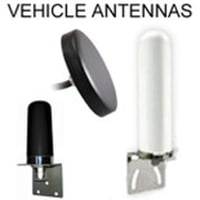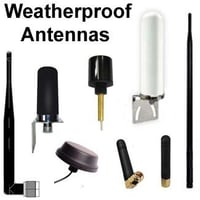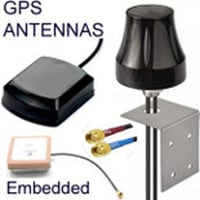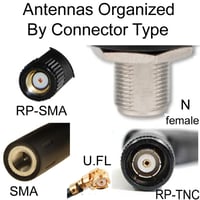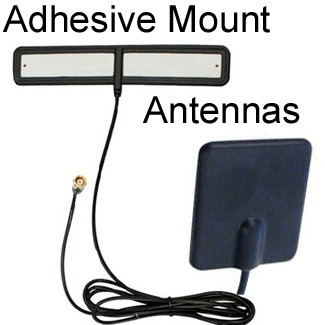Omni-Directional 2.4GHz WiFi Antennas
Dipole Antennas: 2.4GHz
Dipole antennas are the most popular and simplest RF antennas. They get their name from the bilateral arrangement of two conductive elements on a common axis separated by an insulator. The impedance and frequency of the conductors are typically determined by the length of the conductors.
The most common frequency for dipole antennas is 2.4GHz frequency band which is the band not only of WiFi and Bluetooth, but also is the Industrial, Scientific, and Medical (ISM) frequency band.
Properties of Dipole Antennas
Dipole antennas provide reliable polarization, omnidirectional radiation patterns, and consistent performance. The ground plane or size of the box will typically not determine the radiation pattern of the dipole antenna. This is because the dipole antenna has two arms that have balanced currents, which means there is little current flow on the chassis or ground plane. The broadside of the antenna typically emits most of the energy which results in a donut-like radiation pattern. The antenna is also isolated from the ground plane that is the metal box that works as the chassis.
Bluetooth Devices
Bluetooth devices operate within the 2.4 GHz if they are used in the short-range personal area networks. The Bluetooth Protocol is divided into 80 channels with each being 1MHz wide to prevent interference with other protocols in the 2.45GHz band. The Protocol also changes channels up to 1600 times in a second. Most Bluetooth antennas use omnidirectional dipole antennas though there is a significant number that uses 2.4 GHz antennas for their connections.
Internet of Things (IoT)
Most IoT devices have very little room for antennas meaning that devices such as noise detectors, vibration monitors or clothing tags have to come in small packages. Many antennas that come with frequencies below 5.5GHz are likely to be very inefficient when they are placed in tiny packages. However, the 2.4 GHz band which is used for technologies such as Wi-Fi, Zigbee, and Bluetooth works well even in small packages. This makes antennas on the 2.4 GHz very effective when used on IoT devices.
2.4 GHz Dipole Antenna Characteristics
A 2.4 GHz dipole antenna is a type of dipole antenna that can receive and transmit radio frequency signals between 2400 and 2500 MHz, which is an unlicensed ISM band frequency. Dipole antennas are basic antennas that consist of two conductive elements and a feedline. As current flows via the feedline through the wire antenna elements they become resonant and radiate electromagnetic energy at their specific frequency. Received radio frequency signals will cause the element to become resonant and the energy is conducted as current towards and down the feedline. The dipole radiating elements are usually on the same plane and divided by the connection of the feedline. Properties and performance of the antenna can be altered by nuance adjustments in the length and orientation of the elements.
There is a wide range of 2.4 GHz dipole antennas which are based on the wavelength at 2.4 GHz. At 2.4 GHz the wavelength is just over 12 centimeters. Types include:
- Half wavelength 2.4 GHz dipole antennas have conducting elements with a net length that is half the wavelength at 2.4GHz (~6cm). They are usually center-fed.
- Quarter wave 2.4 GHz dipole antennas are more compact designs that have an antenna element that is a quarter of the 2.4 GHz wavelength (~3cm).
- Short 2.4 GHz dipole antennas have an antenna wire with a length that is shorter than the wavelength.
- Folded 2.4 GHz dipole antennas have the dipole element folded back on itself to create a loop that is only interrupted by the antenna feedline.
2.4 GHz Dipole Antennas Types & Applications
The simplicity of the dipole antenna design means that it is highly versatile and adaptable to a range of applications. The wavelength at 2.4 GHz also means that dipole antennas can be created which are not excessively large making them a convenient and portable option for boosting connectivity in a variety of settings. These antennas are also easy for users to handle and install as part of wireless products and solutions that are aimed at consumers.
Key types of 2.4 GHz dipole antennas
[A] Omnidirectional antennas transmit and receive 2.4 GHz radio frequency signals in all directions in the horizontal plane. Depending on their gain, (which can be lower than directional antennas because their beam is unfocused), they can be used to provide extensive indoor and outdoor coverage. They are provided with a range of mounting options, including magnetic mounting.
[B] Rubber Duck antennas have part or all of the antenna element helically coiled to produce a springy antenna which is typically rubber or plastic coated.
[C] Stub antennas are extremely compact units that have the main element coiled down to create a smaller size.
These antennas also carry an integrated connector that facilitates direct connection to a radio device or coaxial antenna cable. It may be a right-angled connector, articulating or rotating. Connectors at this frequency are usually RP-SMA, but can also be SMA, TNC, or N-type depending on the requirement. They are routinely impedance matched to 50 Ohms and so are compatible with standard antenna cables and adapters.
Because the 2.4 GHz frequency is not subject to licensing and other regulatory restrictions, this frequency is used by a wide variety of wireless networking applications and protocols. It also has the benefit of providing a good range and indoor coverage due to the penetration of radio waves at this frequency. This means that a generic 2.4 GHz dipole antenna can be integrated into a variety of technologies to optimize radio use. Here are the key technologies that use 2.4 GHz for networking:
- 2.4 GHz dipole antennas for WiFi
The 802.11 wireless local area networking standard produced by the Institute of Electrical and Electronics Engineers (IEEE) is known and marketed as WiFi. Since its first release in the late 1990s, it has had 5 versions with the latest, WiFi 6 (802.11ax), expected in late 2020. WiFi has taken the lead for high speed and high throughput wireless networking. Compatible devices can utilize WiFi with data rates at 2.4 GHz of up to 54 Mbps (802.11g). Data is transmitted via one of eleven channels or sub-bands in the US, with higher numbers of 20 MHz frequency channels available in Europe and Asia. 802.11 WiFi standards specify the specific technology and modulation techniques that facilitate data transfer. Though WiFi is operable at both the 5 GHz and 2.4 GHz frequencies, the 2.4 GHz frequency provides greater coverage and penetration of signal. The majority of WiFi versions will accommodate this frequency, namely:
- 802.11b
- 802.11g
- 802.11n
An external dipole antenna can be used with WiFi signal boosters, repeaters, and access points as described below to improve the quality and speed of WiFi connectivity.
- 2.4 GHz dipole antennas for Bluetooth
Bluetooth is a technology that provides short-range personal area networking for a wide range of compatible devices and appliances. It uses the 2.4 GHz frequency band following a proprietary specification based on the IEEE protocol 802.15.1. The Bluetooth Special Interest Group oversees the development of Bluetooth wireless networking standards and the specification and certification of compatible devices. It has several classes that vary in their maximum permitted power and the range that can be achieved. Most Bluetooth enabled devices are battery-powered Class 2 devices. The short-range connectivity provided has low energy consumption and mesh networking with communication via sequences of 'nodes' can achieve distances above the standard range that is tens of meters. External or replacement 2.4 GHz dipole antennas can be used as Bluetooth antennas in a variety of projects. The use of these antennas with a short pigtail connector allows direct connection to PCBs on Bluetooth transmit/receive devices that carry the proprietary integrated circuit chips. The use of an externally attached Bluetooth antenna with a Bluetooth module will increase its transmission range and save on space within the device. Bluetooth repeaters with higher gain external antennas can also be used to increase Bluetooth signal coverage.
- 2.4 GHz dipole antennas for ZigBee
ZigBee is a personal area networking technology that has extensive smart home applications due to its low power and low data rate functionality. Data rates of between 20 and 250 kbps support short simple transmissions. Its transmission range is limited to under 100 meters, which is adequate for the ‘smart home’ star or mesh sensor-based networks that can be created with it. Networked devices carry the ZigBee module and are available in three classes:
- ZigBee coordinator devices or controllers are used to program and control the network.
- ZigBee router devices can send onward data from the controller to downstream nodes and receive data from end devices and transmit it to the controller.
- ZigBee end devices can transmit small amounts of data towards the controller.
2.4 GHz antennas can be used within ZigBee networks to extend the range of the network or improve signal quality for the participating appliances. The indoor environment can be challenging for signal propagation with limited line of sight and so external ZigBee antennas can be used to overcome obstructions and create an optimally performing network.
2.4 GHz dipole antennas for access points
An access point (AP) is an Ethernet-cabled hub that provides wireless connectivity for networked devices. Some APs have internal antennas, but others come equipped with external 2.4GHz antennas that can be exchanged, to further improve network coverage. Antennas can be connected with higher gain or via antenna cable to facilitate mounting in a better position at a distance from the AP. A more hardy, outdoor weatherproof 2.4 GHz antenna may be necessary. The choice of 2.4 GHz antenna can also be refined by its specific characteristics (e.g. directivity, radiation pattern), which may save the time and expense of changing or moving the entire AP.
2.4 GHz dipole antennas for routers
Attachment of a high gain antenna to a WiFi router is a key method of boosting signal quality and speed. However, the antenna must be able to operate according to the version of WiFi used by both the router and connected devices. Not all versions of WiFi are backward compatible, which means that a router that has a more recent version of WiFi networking will fail to deliver optimal connectivity if connected to a laptop that has an older version of WiFi with limited data rate. Also, routers that provide both 2.4 and 5 GHz connectivity may require that a 2.4 GHz external antenna is connected to a 2.4 GHz port for correct functioning.
2.4 GHz dipole antennas for repeaters
Repeaters can be used to receive, amplify, and broadcast an existing wireless networking signal. By using external 2.4 GHz dipole antennas, the repeated signal can be directed to where it is needed most. The external antenna is usually screwed into the connector port on the repeater or via a length of antenna cable that can be run to position the antenna wherever needed. If using coax with an external antenna, the cable run should be kept as short as possible to prevent signal loss along its length.
Frequently asked Questions
- Can I use a 2.4GHz dipole antenna to improve my wireless CCTV camera's connectivity?
Wireless Closed Circuit Television connectivity on your property can be affected by the multipath interference that is common at 2.4 GHz or poor line of sight with varying obstructions. A weak or faded signal can be improved by the strategic use of 2.4 GHz high gain (up to 9dB available here) dipole antennas. External 2.4 GHz dipole antennas should be set up and networked outside your building with a coaxial antenna cable run through to the receiver inside. A second antenna should be attached to the camera's transmitter to boost its signal. Ensure that the receiving antenna is mounted at height with visibility of the camera's transmitter. If you have only one antenna available, it is best to connect it to the transmitting antenna as a single receiving antenna will amplify everything including any interference present
- Can I use an external 2.4 GHz dipole antenna to boost my laptop’s WiFi connectivity?
A WiFi antenna booster can be equipped with a good quality external 2.4 GHz dipole antenna to boost reception if the in-built WiFi PCI card and antenna have poor performance and WiFi speed is slow. Dongles with an external antenna have a much stronger WiFi signal.
USB WiFi boosters can be plugged into a compatible USB 1,.1, 2.0, or 3.0 port and some designs offer multi-antenna networking and the ability to upgrade WiFi connectivity to the more recent protocols like 802.11ac.
- Is 2.4 GHz a frequency used for the Internet of Things (IoT)?
The 2.4 GHz frequency was a candidate for supporting widespread IoT and M2M networking, but its use has been largely eclipsed by Low Power Wide Area Networking (LP-WAN) at lower frequencies like 915 MHz and 433 MHz. At these frequencies, much greater coverage can be achieved with great penetration of building and low energy consumption form battery-powered sensor-based devices that transmit small amounts of data infrequently. Technologies which as LoRa and SigFox take advantage of these lower frequency portions of the spectrum.
In conclusion
2.4 GHz dipole antennas are a flexible solution for reliable connectivity for your local area networking. The dipole design provides consistent performance due to the balanced current between the two conductive elements of the antenna. It is important to remember that when selecting your antenna you should ensure that the connector is compatible, especially as the SMA and RP-SMA antenna connectors widely used for this frequency look externally identical, but are unable to form an electrical connection.
LEARN MORE:

